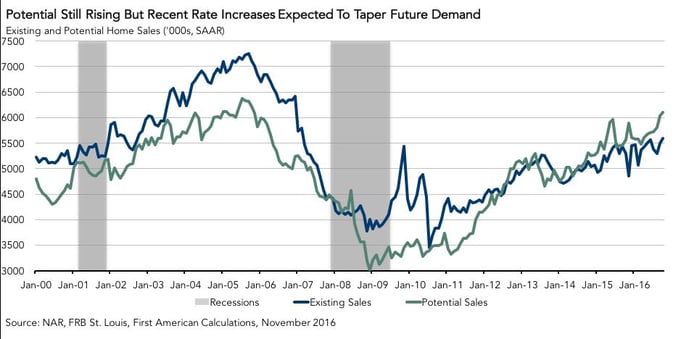First American Chief Economist Mark Fleming shares his proprietary Potential Home Sales model for November, with analysis of the housing market's overall health.
"Like the 'taper-tantrum' in 2013, rising mortgage rates will cool market potential for home sales and dampen home price appreciation in 2017, although not as severely."
November 2016 Potential Home Sales
For the month of November, First American updated its proprietary Potential Home Sales model to show that:
- Potential existing-home sales increased to a 6.1 million seasonally adjusted, annualized rate (SAAR).
- This represents a 103.5 percent increase from the market potential low point reached in December 2008.
- In November, the market potential for existing-home sales grew by 4.0 percent compared with a year ago, an increase of 233,000 (SAAR) sales.
- Currently, potential existing-home sales is 98,000 (SAAR) or 1.6 percent below the pre-recession peak of market potential, which occurred in July 2005.
Market Performance Gap
- The market for existing-home sales is underperforming its potential by 8.4 percent or an estimated 515,000 (SAAR) of sales.
- Last month’s revised underperformance gap was -8.6 percent or 526,000 (SAAR) sales.
Tight Inventories Keeping Market Under Potential, Rising Mortgage Rates are Expected to Cool Potential Home Sales into 2017
“The market potential for existing-home sales continues to grow based on the strength of the broader economy, particularly wage growth, as well as improving access to credit. But, the market continues to underperform its potential, primarily a result of persistently tight inventory,” said Mark Fleming, chief economist at First American. “The post-election ‘Trump Bump’ in long-term U.S. treasury yields that triggered mortgage rates to rise above 4 percent, as well as the increase in the Federal Funds rate last week, will likely have a modest cooling impact on potential home sales heading into 2017.
“While rising rates reduce affordability for potential first-time homebuyers, the expected moderation of price appreciation will align house price growth more closely with recently increasing income growth to help offset reduced affordability in the year ahead,” said Fleming.

Chief Economist Analysis Highlights
- According to the National Association of Realtors, existing-home sales grew 2.0 percent between September and October to 5.6 million (SAAR). Market gains remain broad-based, as the growth in sales was again seen across all four Census Regions.
- As we discussed in a post earlier this month, the post-election increase in mortgage rates, while not yet impacting sales activity, is expected to slow the pace of existing-home sales and house price appreciation in 2017.
- Home price appreciation is typically more sensitive to mortgage rate increases and I expect to see a decline in the house price growth rate of almost a full percentage point by the end of 2017.
- The “taper-tantrum” in 2013, which was a larger increase in mortgage rates than we have seen in recent weeks, produced a similar result – a decline in sales activity, but a more pronounced decline in house price appreciation.
What Insight Does the Potential Home Sales Model Reveal?
When considering the right time to buy or sell a home, an important factor in the decision should be the market’s overall health, which is largely a function of supply and demand. Knowing how close the market is to a healthy level of activity can help consumers determine if it is a good time to buy or sell, and what might happen to the market in the future. That’s difficult to assess when looking at the number of homes sold at a particular point in time without understanding the health of the market at that time. Historical context is critically important. Our potential home sales model measures what we believe a healthy market level of home sales should be based on the economic, demographic, and housing market environments.
About the Potential Home Sales Model
Potential home sales measures existing-homes sales, which include single-family homes, townhomes, condominiums and co-ops on a seasonally adjusted annualized rate based on the historical relationship between existing-home sales and U.S. population demographic data, income and labor market conditions in the U.S. economy, price trends in the U.S. housing market, and conditions in the financial market. When the actual level of existing-home sales are significantly above potential home sales the pace of turnover is not supported by market fundamentals and there is an increased likelihood of a market correction. Conversely, seasonally adjusted, annualized rates of actual existing-home sales below the level of potential existing-home sales indicate market turnover is underperforming the rate fundamentally supported by the current conditions. Actual seasonally adjusted, annualized existing-home sales may exceed or fall short of the potential rate of sales for a variety of reasons, including non-traditional market conditions, policy constraints and market participant behavior. Recent potential home sale estimates are subject to revision in order to reflect the most up-to-date information available on the economy, housing market and financial conditions. The Potential Home Sales model is published prior to the National Association of Realtors’ Existing-Home Sales report each month.



